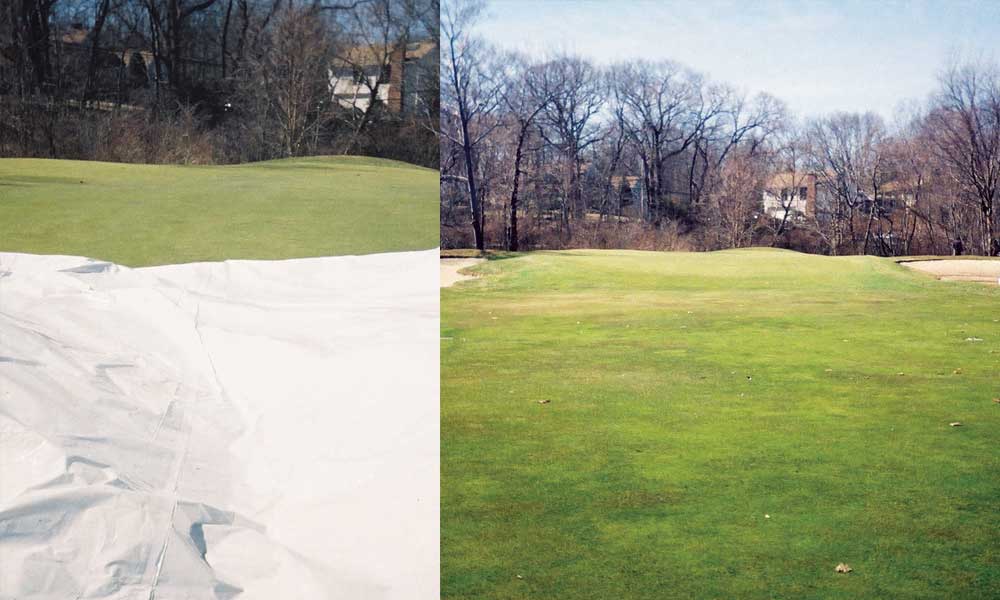The Cold Hard Facts about Winter Damage to Your Golf Course


Is your golf course ready for another winter like last winter? From record snowfall in New England to record cold temperatures in much of the north and deep into the southeastern and southcentral U.S., the winter of 2014-2015 was a winter to remember… or perhaps a winter to try and forget.
Although predictions suggest otherwise, maybe this winter will be milder. Ironically, weather that is more temperate may not make for better outcomes on your golf course. The freezing and thawing that occurs during warmer or atypically wet winters can be more destructive to a golf course than the damage wreaked by ice and heavy snowfall. Winter injury from snow mold, direct kill by ice, low temperature ice injury, winter crown hydration or the winter desiccation that occurs when water in plants is lost at a faster rate than it is replaced leave wounds and battle scars that can last long after winter has passed.
Topdressing, snow fences and winter covers are some of the ways to minimize damage but before you put these tools to work, you must understand how to use each technique and which one(s) will best serve your needs.
To Cover or Not to Cover
In areas where annual snow cover is adequate and consistent, snow provides natural insulation to help reduce some types of winter injury. With consideration to the climatic changes evidenced in recent years, many golf course superintendents are finding it difficult to rely on snow as an insulation strategy.
GreenJacket®, makers of GreenJacket IMPERMEABLE turf covers along with the AFS Air Flow System insulation system suggests that the question is no longer whether covers work to protect your turf, but rather, which covers work best–a question the company believes it has successfully answered. Although the GreenJacket story started with a chilly beginning, as you’ll see, it warmed up quickly.
In 1996, Roger Kisch, who is both a golf industry professional widely recognized for his innovative practices and the course superintendent at Southview Country Club in West St. Paul, Minnesota, placed a phone call to Jim Stoller of Sto-Cote Products, Incorporated. Sto-Cote, a family business established in 1948, is a leader in the manufacture of engineered plastic films for industrial applications.
Roger contacted Sto-Cote seeking a covering that would help him protect Southview’s golf greens from winter damage. Jim, who is today President, Sales and Marketing for GreenJacket, said, “I told Roger about our NiceRink outdoor ice rink division and the type of white liners we produced to make the rinks work. I explained to him how my grass came through each year after having 18 inches of ice on it for three months, but I added only half-jokingly that while this particular product should work, he couldn’t blame me if it didn’t.”
The following spring, Jim received a call from Roger who said, “You need to come up here to Minnesota right away to see how it worked!”
…and so the GreenJacket® Project began. Soon, other golf courses in the Twin Cities area were hearing about the amazing success Southview Country Club had in using ice rink liners on its greens. From there, the story (and the product) moved quickly.
Jim explained, “We knew we had something new and special; we looked and could not find anything like our impermeable GreenJacket cover, and we were right. Over the years, the impermeable GreenJacket, its systems and associated products, have been awarded multiple U.S. and Canadian patents of protection and trademarks with more pending as we continue to enhance the GreenJacket Cover System and develop new products and ideas for the turf industry.
“GreenJacket is a unique product in itself, and has become even better over the 20 years we’ve been testing, using and tweaking the product and its processes. The science behind the success gets very in-depth as to the ’how’ and ’why’ it is successful. Learning from our mistakes has made GreenJacket the innovation leader in winter turf protection. We often say, ’With time, comes experience. With experience comes knowledge. Knowing how to use that knowledge is what matters.’”
What Makes the GreenJacket AFS (Air Flow System) insulation So Distinctive?
GreenJacket AFS Air Flow System insulation offers a method for insulating your turf while still providing for air movement as needed under the impermeable GreenJacket turf cover. The product is a UV-resistant, non-woven PET staple fiber, bonded with a blend of non-water-soluble acrylic resins. Tested to suspend a snow or ice load of 50 pounds per square foot, the AFS Air Flow System permits airflow to move freely even under a capacity load.
The GreenJacket Impermeable Cover and AFS Air Flow System
- Functions as a barrier to water, ice, snow, desiccation, and cold temperatures
- Works in conjunction with the GreenJacket vent tubing system, allowing air to transfer passively under the cover and throughout the covered surface
- Can be used with a leaf backpack blower and vent tubing providing positive air exchange
- Is easy to handle and install
- Is tear-resistant and unaffected by wind, offering a long, useful lifecycle
- Offers integrated strength (tensile strength enhanced over original GreenJacket products), yet remains lightweight and easy to store
- Is available in a light-reflecting white color
- Is manufactured in custom sizes
- Reflects sunlight to help minimize temperature fluctuations
Keeping Your Turf Dormant
Each winter, turf needs time to acclimate and “harden-off,” allowing it to become more winter tolerant. Although at first it may seem counterintuitive, the success of GreenJacket turf covers lies not in effectively keeping turf warm, but instead in effectively keeping turf cold once it has become winter acclimated.
For best results, maintenance crews should not install GreenJacket impermeable covers until the turf has “hardened” off, and the top inch or so of ground has frozen. When impermeable covers are installed too soon, the acclimation process is thwarted, with excessive heat, water vapor and respired gasses trapped under the cover.
Paramount to Making the GreenJacket System Work Correctly
Scheduling of crews, seasonal reductions in maintenance workers or the simple fact that no one can accurately predict the weather can lead to the installation of impermeable covers before the ground is frozen. In these instances, if the GreenJacket AFS Air Flow System is in place, workers can create necessary positive air exchange by using a backpack leaf blower on each covered green for as briefly as fifteen minutes, once per week until the ground is frozen and plants and turf have properly acclimated.
If weather cycles bring unseasonably warm temperatures at any time during the winter months and a thaw occurs, the GreenJacket Air Flow System can again be used to control oxygen depletion and reduce surface moisture and the likelihood of winter injury from crown hydration.
The Numbers Speak for Themselves
In 2004, the Tedesco Country Club in Marblehead, Massachusetts conducted independent testing that included GreenJacket impermeable covers, another brand’s woven polyethylene clear or translucent permeable covers, and a control of uncovered turf. Over a seven-day period that commenced on March 22 and concluded on March 29, temperature readings were taken on the green’s surface every two hours.
The charts included here plot the results, showing the temperature variations as recorded by data loggers positioned on the green’s surface where it remained uncovered in the control; the temperature variations on the green’s surface beneath the GreenJacket impermeable cover; and the temperature variations on the green’s surface beneath the permeable “grow-in” cover. The results clearly illustrate how effectively GreenJacket aids in controlling temperature fluctuations, helping ensure that turf remains dormant until spring temperatures have stabilized and it is safe to remove the covers for the season.
Who’s Using GreenJacket Impermeable and Permeable Products?
Currently the GreenJacket sales team serves all of the United States, and Canada and Scandinavian Europe. You’ll find the GreenJacket impermeable covers in use in the U.S. from Maine to Montana to Alaska, and in Canada from the Rockies to Prince Edward Island, but you will also find them on golf courses as far south as San Antonio, Texas, West Monroe, Louisiana and Saltillo, Mississippi. Any turf manager or golf course superintendent who deals with ice or freezing temperatures has a reason to consider impermeable covers.
Note: GreenJacket also offers permeable covers that are suitable for overnight frost protection and as grow-in covers. Permeable covers permit water and gas exchange at the turf surface. The decision to cover greens, whether with permeable or impermeable covers, involves many factors beyond temperature and precipitation, including topography, turfgrass composition and a maintenance crew’s capacity to install and remove covers at the optimum times.
GreenJacket representatives live by the company’s motto: “The grass is always greener on the UNDERSIDE.” To find out more about GreenJacket’s patented impermeable and permeable coverings and its airflow system, visit www.greenjacket.com.
Weathering the Winter Storm
Just as no two golf courses are the same, neither are the weather conditions of any two winters. Golf course superintendents must adjust their winter plans from year to year. Understanding how to get the most out of the tools and techniques used affords the best possible leverage for dealing with whatever Old Man Winter has in store this year and in years to come.
Recent Posts
Discover the New Graves Golf Club: A Game-Changing Facility in Edmond, OK
Graves Golf Club, the much-anticipated golf and training destination founded by celebrated instructors Tim and…
Circling Raven Named Idaho’s Top Public Course by GOLF Magazine
The ratings are in and expert panelists for GOLF Magazine (golf.com) rank Circling Raven Golf…
Q&A with a Multi-talented Golf Course Architect – Part 1: Making the Rounds – Installment 38
This column features recollections of the author’s 37 years as a golf writer. These installments…
Ortmeier, Tingen receive Grassroots Ambassador Leadership Awards from GCSAA
Chris Ortmeier, director of agronomy at Champions Golf Club in Houston, Texas, and Clinton Tingen,…
Sir Nick Faldo and Himalayas Golf Launch ‘Golf in Small Spaces’ to Redefine Where the Game is Played
Golf is evolving, and Sir Nick Faldo is helping lead the charge. The six-time major…
Mark McCarel Joins EnP as Northeast Territory Sales Manager
Specialty fertilizer manufacturer EnP Investments is proud to welcome Mark McCarel as their Northeast Territory…


